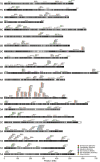A global assembly of landrace oat (Avena sativa L.) accessions is a discovery resource for adaptive variation, association mapping, and trait deployment
- PMID: 40273399
- PMCID: PMC12134994
- DOI: 10.1093/g3journal/jkaf093
A global assembly of landrace oat (Avena sativa L.) accessions is a discovery resource for adaptive variation, association mapping, and trait deployment
Abstract
Crop adaptation to environmental change will require genetic resources that are different from those currently deployed. The rapid global shift to both warmer temperatures and unpredictable atmospheric events must be considered in developing new breeding populations for local environments. Oats (Avena spp.) are annual grasses that represent a diversity of species and ploidy levels. The most notable, spring oat (Avena sativa L.), is a heart-healthy and gluten-free cereal crop that is grown worldwide as a source of food, feed, and cosmetics products. In the past decade, global oat production has been increasingly challenged by environmental stress and its economic value has suffered due to competition with other high-value grain crops. Although genomic resources are growing for spring oat, there is limited information about the landraces that served as founders to modern varieties. To improve knowledge of adaptive genetic variation and phenotypic diversity of spring oat founders, a set of 758 global A. sativa landrace accessions from the USDA-ARS National Small Grains Collection was investigated, herein dubbed the "Oat Landrace Diversity (OLD) Panel." High-depth genotyping-by-sequencing was conducted to assess genetic diversity, perform genome-wide association mapping for environmental variables, and provide insight into whether quantitative trait loci identified in the OLD Panel have been deployed in modern cultivar populations. Finally, we discuss the importance of leveraging genetic variation attributable to environmental adaptation to reinforce plant breeding programs from ecological instability.
Keywords: GWAS; QTL; adaptation; founder population; functional traits; landrace; oats.
Published by Oxford University Press on behalf of The Genetics Society of America 2025.
Conflict of interest statement
Conflicts of interest: The authors declare that the research was conducted in the absence of any commercial or financial relationships that could be construed as a potential conflict of interest. Mention of trade names or commercial products in this publication is solely for the purpose of providing specific information and does not imply recommendation or endorsement by the U.S. Department of Agriculture. USDA is an equal opportunity provider and employer.
Figures




Similar articles
-
Genomic strategies to facilitate breeding for increased β-Glucan content in oat (Avena sativa L.).BMC Genomics. 2025 Jan 14;26(1):35. doi: 10.1186/s12864-024-11174-5. BMC Genomics. 2025. PMID: 39810135 Free PMC article.
-
Genetic diversity and genome-wide association analysis in Chinese hulless oat germplasm.Theor Appl Genet. 2020 Dec;133(12):3365-3380. doi: 10.1007/s00122-020-03674-1. Epub 2020 Sep 4. Theor Appl Genet. 2020. PMID: 32888041
-
Genome-Wide Association Mapping of Barley Yellow Dwarf Virus Tolerance in Spring Oat (Avena sativa L.).PLoS One. 2016 May 13;11(5):e0155376. doi: 10.1371/journal.pone.0155376. eCollection 2016. PLoS One. 2016. PMID: 27175781 Free PMC article.
-
Oats in healthy gluten-free and regular diets: A perspective.Food Res Int. 2018 Aug;110:3-10. doi: 10.1016/j.foodres.2017.11.031. Epub 2017 Nov 21. Food Res Int. 2018. PMID: 30029703 Review.
-
Genotyping-by-Sequencing and Its Application to Oat Genomic Research.Methods Mol Biol. 2017;1536:169-187. doi: 10.1007/978-1-4939-6682-0_13. Methods Mol Biol. 2017. PMID: 28132151 Review.
References
-
- Asoro FG, Newell MA, Beavis WD, Scott MP, Tinker NA, Jannink JL. 2013. Genomic, marker-assisted, and pedigree-blup selection methods for β-glucan concentration in elite oat. Crop Sci. 53(5):1894–1906. 10.2135/cropsci2012.09.0526 - DOI
MeSH terms
Grants and funding
LinkOut - more resources
Full Text Sources
Miscellaneous
